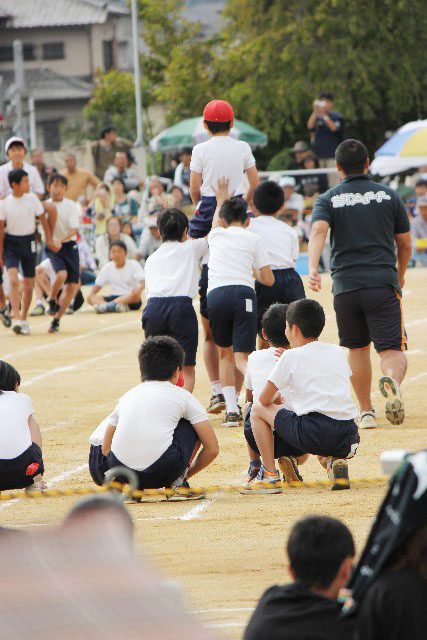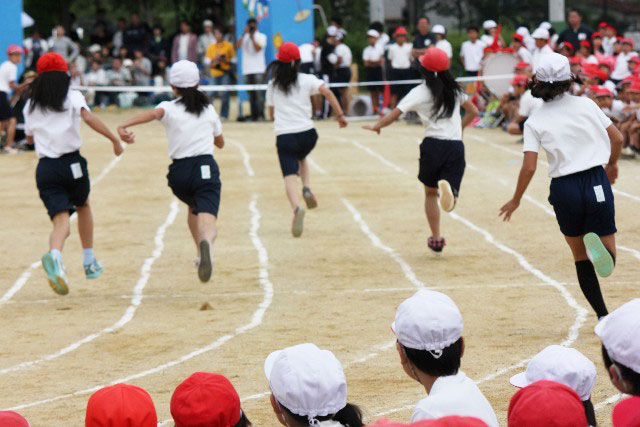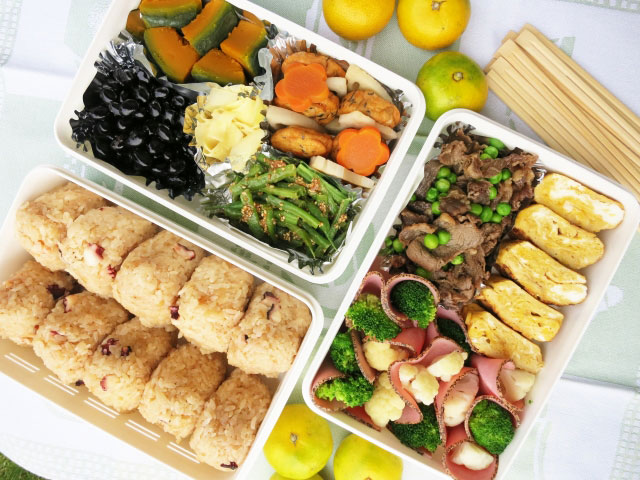Undo-kai time is here!
Every year in Japan, schools hold sports festivals showcasing their students’ physical talents in competitive and cooperative sports. Families and members of the community all assemble at their local or school stadium and watch children at each grade level compete in track and field, dance, o-en-dan, kumi-taiso, ki-ba-sen, tama-ire and ball games.
Undo-kai festivals are daylong events, and often coincide with the National Sports Day holiday on October 10, which commemorates the opening of the 1964 Olympic Games in  Tokyo. The day begins in the morning, with a procession of children marching to music in their gym uniforms – red teams (aka gumi) separated from white teams (shiro gumi) by the color of their hats. Families spread out blankets on the nearby grass, and lay out their cushions and picnic lunches, ready for the morning’s performances. Children on each team warm-up and stretch, the o-en-dan cheering squads perform dances to music and taiko drums, and the track and field and ball games begin!
Tokyo. The day begins in the morning, with a procession of children marching to music in their gym uniforms – red teams (aka gumi) separated from white teams (shiro gumi) by the color of their hats. Families spread out blankets on the nearby grass, and lay out their cushions and picnic lunches, ready for the morning’s performances. Children on each team warm-up and stretch, the o-en-dan cheering squads perform dances to music and taiko drums, and the track and field and ball games begin!
Each team has been practicing for this event, from the youngest first grader to older sixth grade students. Each member of the team contributes to the team’s points, which will be tallied at the end of the day to declare a winner. The morning’s competition breaks for one of the highlights for families…a picnic or bento lunch.
Students share the bento lunch with their families, taking a long break in the shade to rest and prepare for the afternoon’s competition. Bento lunches are as much a part of the Undo-kai tradition as the games themselves. Parents and grandparents have been up since early morning preparing onigiri, fresh vegetables, fruit, desserts, chicken, fish, shrimp, omelets, sausages, salads, pickles and sandwiches. The shapes and colors and textures of the food, all delicately seasoned, is a sight to see! Freshly-brewed tea is loaded into insulated bottles and the entire feast is packed in beautiful, stackable bento boxes.
After eating until everyone is satisfied, the children return to the games, and the afternoon’s competitions of kumi-taiso (group gymnastics), ki-ba-sen (shoulder war), dancing and music continue as more points are collected for each team. Finally, the games end, and the scores for each team are announced. The school principal and representatives from each team lead the closing ceremonies. Win, lose or tie, each team has demonstrated a quintessentially Japanese trait… cooperation, even while competing.


Leave a Reply